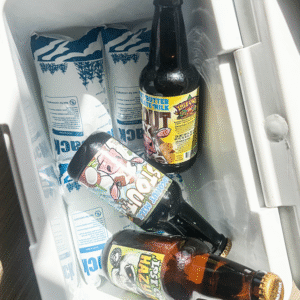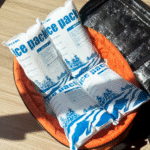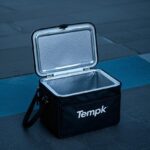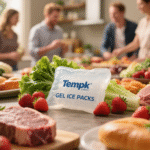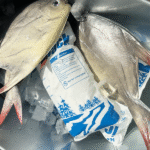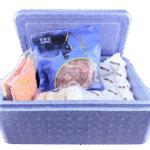Paquete pequeño de hielo seco: Elegir, Tamaño & Envolver 2025
Si necesita un paquete pequeño de hielo seco que mantenga envíos congelados y cumplidos, Aquí está el libro de jugadas. Elige una bolsa amigable para ventilación, tamaño del refrigerante correctamente, y aplicar UN1845/clase 9 Etiquetas para el aire. El viaje de los pasajeros está limitado a 2.5 kg, y USPS Air Mail Caps Sroto Ice a 5 lb por pieza. Use el estimador de tamaño a continuación para planificar la masa antes de una prueba de carril.
-
Cuando un paquete pequeño de hielo seco supera el gel/pcm Para la verdadera integridad congelada en los carriles de parcelas
-
¿Cuánto paquete pequeño de hielo seco necesitas? durante 24–72 horas a través de leve, cálido, y rutas calientes
-
Cómo empacar y etiquetar bajo PI954 (UN1845) Entonces los operadores aceptan su caja la primera vez
-
Seguridad y 2025 actualizaciones Eso es el aire, suelo, y viajes de pasajeros
¿Qué es un Paquete pequeño de hielo seco—Y cuándo deberías usarlo?
Un paquete pequeño de hielo seco es un compacto, Configuración ventilada que contiene hielo seco dentro de un remitente aislado para mantener cargas útiles ≤ - 18 ° C durante 24–72 horas. Úselo cuando el producto debe permanecer completamente congelado de extremo a extremo y su operador acepta UN1845. Evite las bolsas selladas; El hielo seco debe desahogarse, ya que sublima a Co₂ Gas.
En términos simples: paquetes de gel a flota cerca de 0 ° C; Muchos PCM se mantienen+3/+5/+7/+17 ° C - Gran carriles refrigerados, no para resultados duros. El hielo seco se encuentra cerca de −78.5 ° C, dándote el margen de la cabeza de profundidad a través de las transferencias y los abiertos de las puertas. Elija Gel/PCM solo cuando una banda fría sea aceptable y desea omitir el manejo de buenos buenos buenos.
Hielo seco paquete pequeño vs. gel/PCM para objetivos de paquetes comunes
Final: Elija la herramienta que coincida con su objetivo de temperatura y restricciones de aceptación.
| Caso de uso (meta) | La mejor selección | Duración típica | Lo que esto significa para ti |
|---|---|---|---|
| Helado, carne (permanecer congelado) | Paquete pequeño de hielo seco | 24–72h | Requiere ventilación + UN1845/Class9 por aire; Integridad congelada robusta. |
| 2–8 ° C farmacéuticos o kits de comida | +5 ° C PCM o gel | 12–96h | Ajustado, banda no fría; Manejo y etiquetado más simples. |
| Confección sensible al calor (+17 ° C) | +17 ° C PCM | 24–72h | Evita la floración; Validar en carriles calientes antes de escala. |
Consejos prácticos para ti
-
Respiradero, no sellar: Nunca se vea por calor con hielo seco en plástico; Use bolsas o bolsas de papel amigas para ventilación.
-
Condición previa: Producto de congelación ≤ - 18 ° C y pre -chille al remitente para extender el tiempo de retención.
-
Distribuir masa: Divida el hielo seco en múltiples paquetes más pequeños y coloque algunos en la parte superior para reducir los puntos calientes.
Instantánea del mundo real: Un croissants enviado por panadería con dos bolsas de papel con ventilación (~ 6 lb total) Dentro de un remitente de EPS. Con etiquetas UN1845/Class9, La caja se mantiene a continuación -15 ° C durante 36 horas y se aprobó la aceptación en el primer intento.
¿Cuánto paquete pequeño de hielo seco necesita para 24–72 horas??
Regla rápida de pulgada: plan 5–10 lb (2.3–4.5 kg) por 24 horas En un enfriador de tamaño de paquete. Use el extremo alto para carriles calientes o frecuentes para las puertas, y agregue un día de búfer para retrasos.
Física -Primer estimador (más preciso): El hielo seco se absorbe 571 kj/kg como sublimes. Multiplique su fuga de calor por hora por horas de tránsito, luego divide por 571, y agregar un búfer del 10-20%. Es un punto de partida confiable antes de la prueba del carril.
Rangos iniciales sugeridos (sintonice después de su primera prueba de carril):
| Duración | Leve (≤22 ° C) | Cálido (23–30 ° C) | Caliente (≥31 ° C) | Por qué esto importa |
|---|---|---|---|---|
| ~ 24h | 2–3kg | 3–5 kg | 5–6 kg | Dividido en ≥2 paquetes; Agregar cobertura superior. |
| ~ 48h | 4–6 kg | 6–8 kg | 8–11 kg | Agregar el lado + paquetes superiores para estabilidad. |
| ~ 72h | 6–8 kg | 9–12 kg | 12–15 kg | Considere una caja más grande o un mejor aislamiento. |
Colocación & tamaño de la caja (detalles prácticos)
-
Volumen de caja: 10–La los cargadores 20L son comunes para un paquete pequeño de hielo seco. Las cajas más grandes aumentan la carga de calor.
-
Capas: Bolsa inferior → carga útil → bolsa superior; Agregar bolsas laterales para > 48h. Llenar los vacíos a la convección lenta.
-
Truco híbrido: Un PCM delgado de -20 ° C tocando el producto puede suavizar las abiertas de la puerta mientras mantiene la masa de hielo seca modesta.
Cómo empacar y etiquetar un paquete pequeño de hielo seco 2025?
Cumplimiento del núcleo (aire): Use el embalaje que Permitir el lanzamiento de Co₂, marca "Dióxido de carbono, sólido "o" hielo seco " + UN1845 + Kg neto, y aplicar un Etiqueta de clase9 en la misma cara. Usa el IATA PI954 Lista de verificación de aceptación en la licitación. Se prohíben las bolsas de plástico selladas.
Step -by -pase sop puede pegar en su manual:
-
Preparar bolsas amigas para ventilación (bolsas o mangas de hielo seco de papel). Hacer no sellar hielo seco hermético.
-
Capa de manera inteligente: paquete inferior → carga útil → paquete superior; Agregar lados para carriles más largos.
-
Aventar el cargador exterior: cierre firmemente pero evite sellos herméticos; Deja un camino de gas.
-
Etiqueta claramente: UN1845 Nombre propio + Kg neto + Etiqueta de clase9 (≥100 mm).
-
Reserve correctamente: Algunos operadores solicitan KG net en la reserva para administrar los límites de la aeronave.
Aire, suelo, USPS, y matices de pasajeros
-
Viaje de pasajeros: ≤2.5 kg (5.5 lb) por pasajero/paquete con aprobación de la aerolínea; el paquete debe desahogarse y estar marcado.
-
Correo aéreo de USPS: ≤5 lb hielo seco por correo bajo instrucción de empaque 9a; Se requieren ventilación y marcas.
-
Notas de transportista: FedEx reitera el plástico sellado y cita un techo de 200 kg/paquete (Muy por encima de las necesidades pequeñas). Reglas de ventilación y marcado de UPS/Express Networks PI954.
SEGURO DE SEGURIDAD DE ICLO SECO SEGURIDAD: reglas simples que evitan incidentes
Lista corta que guarda los dolores de cabeza: ventilar la habitación, Use guantes aislados y protección para los ojos, y nunca trampa co₂ en capas selladas. Entrene al personal para manejar piezas pequeñas con pinzas y evitar empacar en vehículos cerrados o habitaciones frías con un bajo flujo de aire.
Lista de verificación de seguridad rápida
-
Aventancia cada capa: bolsa → forro interior (abierto) → cargador exterior (ventilado).
-
PPE: guantes crio -compatibles, gafas de seguridad mínimo.
-
Sin sellos herméticos: Nunca se vea por calor con hielo seco en plástico; Deja un camino de gas.
-
Áreas de escenificación: Mantenerse fuera de los espacios confinados; Co₂ puede agrupar y desplazar el oxígeno.
2025 Actualizaciones y tendencias de paquetes pequeños de hielo seco
Qué hay de nuevo: 2025 Ayudas laborales del operador enfatiza envasado ventilado, Clear UN1845 Marcas, y proporcionar kg net en la reserva. Espere auditorías de aceptación que verifiquen listas de verificación PI954 incluso para parcelas muy pequeñas. La disponibilidad minorista de hielo seco sigue siendo fuerte a través de los principales supermercados para los últimos minutos.
Últimos desarrollos de un vistazo
-
Documentación más fuerte: El apéndice 66 edición de IATA apretó las solicitudes de datos de reserva de hielo seco.
-
Paquetes más seguros: Páginas de portador Estrés Sin plástico sellado y ventilación adecuada.
-
Alternativas refrigeradas maduros: +3/+5/+7/+17 ° C PCMS ahora cubren muchos carriles no fríos sin manejo de DG.
Insight del mercado: Los cargadores reservan cada vez más un paquete pequeño de hielo seco para verdaderos carriles congelados y cambiar de 2 a 8 ° C trabajo a PCMS para reducir las etiquetas, recargos, y riesgo de excepción: todo mientras mantiene la integridad del producto.
Preguntas frecuentes
¿Cuánto paquete pequeño de hielo seco para 48 horas??
Plan 10–20 lb Dependiendo del aislamiento y el calor ambiental; Agregue un día de búfer para retrasos o centros calientes.
¿Qué etiquetas van en un paquete pequeño de hielo seco por aire??
Aplicar UN1845 nombre de envío adecuado, Kg neto, y un Clase9 etiqueta (≥100 mm) en la misma cara; Siga la lista de verificación de aceptación PI954.
¿Puedo sellar hielo seco en una bolsa de plástico??
No. Se prohíbe el plástico sellado. El embalaje debe permitir que Co₂ escape de manera segura.
¿Cuál es la asignación de pasajeros??
Arriba a 2.5 kg (5.5 lb) por pasajero/paquete con aprobación de la aerolínea; El paquete debe desahogarse y estar marcado.
¿USPS permite hielo seco??
Sí. Correo aéreo las piezas se limitan a ≤5lb y debe cumplir con la instrucción de empaque 9a.
Resumen & recomendaciones
Control de llave: Un paquete pequeño de hielo seco ofrece un control profundo profundo cuando el gel/PCM se queda corto. El éxito proviene de envasado ventilado, UN1845 + Kg neto + Clase9 marcas, y dimensionamiento con el 571 kj/kg Estimador antes de la validación del carril. Siga PI954 y las variaciones del operador para evitar rechazos.
Siguientes pasos (plan de acción):
-
Tiempo de tránsito de mapa y picos ambientales.
-
Comenzar con 5–10 lb por 24h y dividido en múltiples paquetes.
-
Imprimir etiquetas a su operador 2025 orientación de carácter.
-
Ejecute una prueba de carril con un registrador; ajustar ± 10-20%.
CTA: Comparte tu carril, masa de carga útil, y tamaño de la caja: devolveremos un SOP de paquete pequeño validado.
Acerca de Tempk
Somos un equipo de envasado de cadena fría enfocado en validación práctica. Combinamos estimaciones térmicas rápidas con pruebas de ruta reales para sintonizar masa de paquete pequeño de hielo seco, Plantillas de marca y etiqueta, y reservar listas de verificación. Los clientes nos eligen para SOPS rápidos y Menos problemas de aceptación—Pacialmente en carriles calientes y rutas de múltiples escalas.
Listo para diseñar tu pequeño paquete? Póngase en contacto con un especialista en TEMPK para una especificación específica de carril y SOP.






